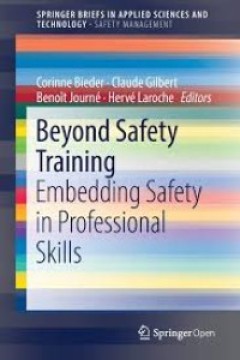Ditapis dengan

EXPLORING RESILIENCE : A SCIENTIFIC JOURNEY FROM PRACTICE TO THEORY
Resilience has become an important topic on the safety research agenda and in organizational practice. Most empirical work on resilience has been descriptive, identifying characteristics of work and organizing activity which allow organizations to cope with unexpected situations. Fewer studies have developed testable models and theories that can be used to support interventions aiming to increa…
- Edisi
- -
- ISBN/ISSN
- 9783030031893
- Deskripsi Fisik
- vi, 128p. : ill.
- Judul Seri
- -
- No. Panggil
- 363.11 EXP e

HUMAN AND ORGANISATIONAL FACTORS : PRACTICES AND STRATEGIES FOR A CHANGING WORLD
This open access book addresses several questions regarding the implementation of human and organisational factors (HOF) so that recent improvements in industrial safety can be built upon. It addresses sources of frustration in senior management with high expectations of operational recommendations and disquiet on the part of HOF specialists struggling to have an impact on high-level decision m…
- Edisi
- -
- ISBN/ISSN
- 9783030256395
- Deskripsi Fisik
- viii, 138p. : ill.
- Judul Seri
- -
- No. Panggil
- 620.86 HUM h

THE ILLUSION OF RISK CONTROL : WHAT DOES IT TAKE TO LIVE WITH UNCERTAINTY?
This book explores the implications of acknowledging uncertainty and black swans for regulation of high-hazard technologies, for stakeholder acceptability of potentially hazardous activities and for risk governance. The conventional approach to risk assessment, which combines the likelihood of an event and the severity of its consequences, is poorly suited to situations where uncertainty and am…
- Edisi
- -
- ISBN/ISSN
- 9783319329390
- Deskripsi Fisik
- v, 112p. : ill.
- Judul Seri
- -
- No. Panggil
- 658.155 ILL i

BEYOND SAFETY TRAINING
This book investigates why, despite more and more resources devoted to safety training, expectations are not entirely met, particularly in the industrial sectors that have already achieved a high safety level. It not only reflects the most precious viewpoints of experts from different disciplines, different countries, with experiences in various industrial fields at the cutting edge of theories…
- Edisi
- -
- ISBN/ISSN
- 9783319655260
- Deskripsi Fisik
- pages cm
- Judul Seri
- -
- No. Panggil
- 363.11 BIE b

THE COUPLING OF SAFETY AND SECURITY :EXPLORING INTERRELATIONS IN THEORY AND P…
This open access book explores the synergies and tensions between safety and security management from a variety of perspectives and by combining input from numerous disciplines. It defines the concepts of safety and security, and discusses the methodological, organizational and institutional implications that accompany approaching them as separate entities and combining them, respectively. T…
- Edisi
- -
- ISBN/ISSN
- 9783030472290
- Deskripsi Fisik
- viii, 113p. : ill.
- Judul Seri
- -
- No. Panggil
- 363.11 COU c

TEXTBOOK OF PATIENT SAFETY AND CLINICAL RISK MANAGEMENT
Implementing safety practices in healthcare saves lives and improves the quality of care: it is therefore vital to apply good clinical practices, such as the WHO surgical checklist, to adopt the most appropriate measures for the prevention of assistance-related risks, and to identify the potential ones using tools such as reporting & learning systems. The culture of safety in the care enviro…
- Edisi
- -
- ISBN/ISSN
- 9783030594039
- Deskripsi Fisik
- xiii, 496p. : ill.
- Judul Seri
- -
- No. Panggil
- 616 TEX t
 Karya Umum
Karya Umum  Filsafat
Filsafat  Agama
Agama  Ilmu-ilmu Sosial
Ilmu-ilmu Sosial  Bahasa
Bahasa  Ilmu-ilmu Murni
Ilmu-ilmu Murni  Ilmu-ilmu Terapan
Ilmu-ilmu Terapan  Kesenian, Hiburan, dan Olahraga
Kesenian, Hiburan, dan Olahraga  Kesusastraan
Kesusastraan  Geografi dan Sejarah
Geografi dan Sejarah